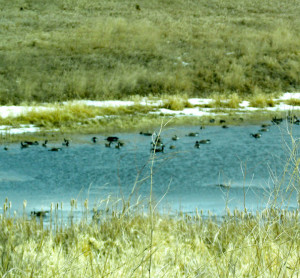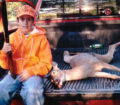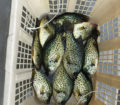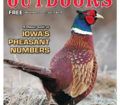By Steve Weisman
As far as I am concerned, I trust migrating waterfowl as a sign of spring more than Punxsutawney Phil! Migrating geese-both Canada and light geese (snows/blues) really showed up here in the Iowa Great Lakes in the past week. The Canada geese will often “set up shop” around here or at least stick around for a while before continuing north. The light geese, however, might be here a day or two or week and then are gone. Even though some come through here, the huge flocks come up through Missouri and Nebraska and then angle their way up through the Dakotas on their way to the Tundra. Some of the refuges along the way will hold over a million light geese at one time!
If you really want to see huge, and I mean huge, flocks of light geese, head west! I’ve been close to fields where there are so many that all you hear is the honking and screeching of thousands upon thousands of geese. Deafening to say the least, and what a sight!
Light goose season
For several years now, in an effort to address the exploding snow/blue goose population, a statewide spring light goose season has been established. This spring that season runs from January18-April 15. It falls under what is called the “Conservation Order Period.”
A current 2014 small game license, habitat license, migratory bird license are required, but a federal duck stamp is not required. Shooting hours are one-half hour before sunrise to one-half hour after sunset. However there is NO bag or possession limit and during this spring season, hunters can use electronic calls and unplugged guns.
Although hunters do find snow geese around here, it takes a lot of scouting to find the fields that the geese are using. The largest concentrations in Iowa are normally found near DeSoto National Wildlife Refuge near Missouri Valley.
Ice conditions on area lakes
Although we have not had a lot of snow this winter, lakes have had ice on them since around Thanksgiving. That’s pushing four full months, and there is really no sign of ice breaking up yet. The average ice-out for Big Spirit Lake is normally around the 4th of April. Probably not in the cards this year!
As a result of the prolonged ice conditions and depth of ice, the fear of winter fish mortality begins to surface.
The DNR recently tested area lakes and found some rather scary results. According to Jim Wahl, supervisor for fisheries in northwest Iowa, Minnewashta, Upper Gar and the lower end of East Okoboji Lake have low oxygen levels. Ice anglers reported seeing dead fish through their underwater cameras in Minnewashta.
The shocking one is Minnewashta. It has an average depth of around 10’ with the deepest spot at 16.5’. I have not found evidence that winter fish mortality has ever been a major issue with Minnewashta. So, what is the deal?
Well, first, I think we can go back to the early freezing. Plus, in the lakes area, we did have a pretty good blanket of snow that has stayed on the lakes pretty much all of the winter. According to Wahl, when lakes freeze early and receive a blanket of snow, it effectively shuts off the sunlight from reaching aquatic plants, which stops photosynthesis and the flow of oxygen into the water. The longer the ice and snow cover stays on the lake, the less oxygen is in the water and available to the fish.
An additional factor in Lake Minnewashta could be the decomposition of a late season algae bloom that robbed additional oxygen from the water compounding the early ice/snow cover factor.
Wahl said even during the most severe winter, a complete kill is seldom observed and fish populations rebound quickly.
“We expect some fish loss but we just won’t know the extent of it until we can get our survey boats on the water and sample lakes that had low winter oxygen readings,” Wahl said.
On several shallow water lakes, the DNR has taken steps to prevent winter fish kills from low oxygen by placing aeration systems to help with winter kills. Aeration systems keep a section of the lake from freezing allowing some oxygen into the water. However, it still does not guarantee a lake won’t winterkill during extreme winters.
Lakes such as Center Lake, Silver Lake (Lake Park) and Ingham Lake have aeration systems, and during recent checks oxygen levels at all three lakes were good.
Let’s hope that the geese right, and that spring is just around the corner!

(photo by Steve Weisman) They’re back! Thousands of Canada geese have shown up on the wetlands and marshes of northwest Iowa.




















